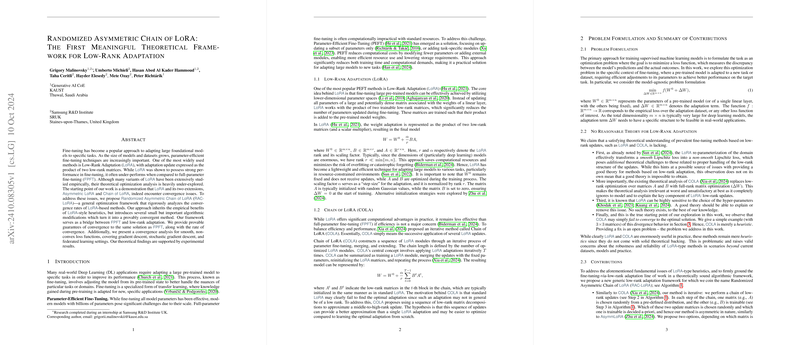An Optimization Framework for Low-Rank Adaptation: RAC-LoRA
The investigation into fine-tuning large-scale deep learning models for specific tasks has underscored the importance of parameter-efficient methods, with Low-Rank Adaptation (LoRA) emerging as a prominent technique. The discussed paper presents a theoretical framework and introduces a novel method, Randomized Asymmetric Chain of LoRA (RAC-LoRA), addressing the convergence issues observed in existing LoRA-based methods.
Convergence Challenges in LoRA Approaches
LoRA, while computationally efficient, frequently underperforms in comparison to full-parameter fine-tuning. This paper critically examines the theoretical optimization aspects of LoRA and its variants, such as Asymmetric LoRA and the Chain of LoRA. A significant portion of the work is dedicated to highlighting the convergence difficulties these methods face, particularly when confronted with non-smooth loss functions. These limitations manifest as the disruption of Lipschitz smoothness in the optimization problem when LoRA is applied, a pivotal smoothness assumption crucial for many optimization techniques. The authors illustrate this with a specific quadratic problem, highlighting non-convergence situations even with relatively small matrix dimensions.
The RAC-LoRA Framework
To address these theoretical deficits, the authors introduce RAC-LoRA, a method that strategically combines asymmetric matrix updates with randomized, iterative improvements. RAC-LoRA employs a unique process where one of the low-rank matrices is random and static during each iteration, helping maintain the structural integrity of the model without sacrificing convergence efficiency. This approach is presented as a robust alternative that theoretically guarantees convergence to the same solution as full-parameter fine-tuning under certain conditions, notably enhancing the efficacy of gradient descent methodologies.
Theoretical Insights and Implications
The rigorous theoretical analysis provided outlines convergence guarantees for RAC-LoRA across various scenarios including non-convex and smooth optimization settings. The implications of these findings extend to federated learning environments, where the computational load and communication overhead need to be minimized. RAC-LoRA leverages its inherent asymmetric structure to provide distinct advantages in such distributed settings, ensuring privacy-preserving and efficient learning.
Results and Future Directions
Experimental results confirm that RAC-LoRA achieves comparable accuracy to full-parameter fine-tuning without the associated computational costs. Additionally, by maintaining the product of randomly initialized and trainable matrices, the method bridges the gap between low-rank and full-rank optimizations more effectively than its predecessors.
This work not only addresses theoretical gaps in LoRA-based methods but also sets a foundation for future advancements in AI model adaptation. The RAC-LoRA method can potentially be extended to broader model architectures and more complex domains, providing a fertile ground for ongoing and future research into parameter-efficient adaptations of large pre-trained models. As AI applications continue to expand, methods like RAC-LoRA will likely play a critical role in maintaining computational feasibility while striving for optimal performance across varied tasks.
